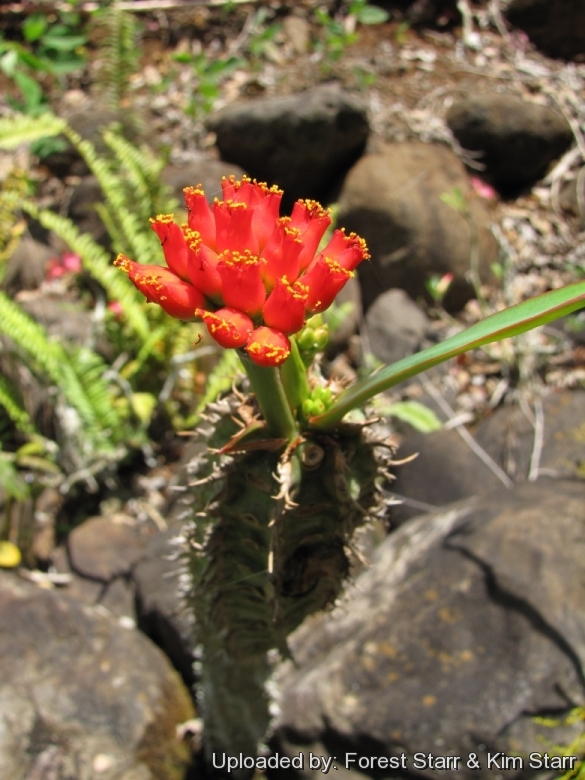
Euphorbia viguieri Photo by: Forest Starr & Kim Starr
Flowering habit at Iao Tropical Gardens of Maui, Maui, Hawaii (USA). May 22, 2012
Origin and Habitat: The species is native to central-northern Madagascar.
Altitude: Around 70-100 metres.
Habitat: It grows in the open coastal forests mainly on strongly eroded calcareous rocks, the fissures of which are filled with humus. It is mainly found on sunny or half-shaded places in deciduous dry forest together with Pachypodium rutenbergianumSN|14816]]SN|14816]], Uncarina sakalava, Uncarina perrieri, Lomatophyllum sp., Commiphora sp., and Cyphostemma sp.
Synonyms:
See all synonyms of Euphorbia viguieri
Common Names include:
ENGLISH: Viguier’s spurge
Description: Euphorbia viguieriSN|25966]]SN|25966]] is a very handsome plant with an angular, bright green stem with vertical, spiralling whitish thorns and vibrant red top-knots of floral parts. It is not a cactus, although it looks like one.
Habit: It is a very variable deciduous spiny succulent species, with a single stem, usually not ramified.
Stems: Narrow at the base up to 80(-150) cm in height, with a diameter up to 3 cm, 5-6-angled and ridged bearing whitish triangular-elliptic leaf scars and rows of irregular spines along the ridges.
Leaves: Simple, clustered towards the tips of branches on a thick and short stalk, emerald green, basally red with white prominent veins on the underside, 6-15 cm long and 3(-6) cm wide, oval, at the end with a little mucro. Tends to be deciduous in winters in cultivation.
Thorns: Laciniate (flat at the base and subdivided towards the apex in several thinner thorns) on a thick tuberculate base, robust, 1.5-2 cm long, secondary thorns longer or shorter.
Inflorescences (axillar cymes): At stem tip, subsessile or on a peduncle long up to about 10 cm.
Flowers (cyathia): Erect surrounded by two brilliant red bracts (cyathofills). The cyathia can be unisexual, even on different plants, or bisexual.
Fruit (capsule): Three-chambered, each one containing only one seed which, when ripe, is expelled and thrown far away.
Subspecies, varieties, forms and cultivars of plants belonging to the Euphorbia viguieri group
Bibliography: Major references and further lectures
1) Forest & Kim Starr “Euphorbia viguieri (Euphorbia)”. Plants of Hawaii. <http://www.starrenvironmental.com>. Web. 27 Sep. 2014.
2) James Cullen, Sabina G. Knees, H. Suzanne Cubey “The European Garden Flora Flowering Plants: A Manual for the Identification of Plants Cultivated in Europe, Both Out-of-Doors and Under Glass” Cambridge University Press, 11/ago/2011
3) Urs Eggli “Illustrated Handbook of Succulent Plants: Dicotyledons” Springer, 2002
4) Leandri, J. “Euphorbiaceae.” Cat. Pl. Madag., Euphorb. 2(23): 1–51. 1935
5) Schill, R. “Cytotaxonomische untersuchungen an sukkulenten vertretern der gattung Euphorbia L. aus Madagaskar.” Ber. Deutsch. Bot. Ges. 84(1/2): 71–78. 1971
6) Rauh, W. “Succulent and Xerophytic plants of Madagascar.” Vol I. Strawberry Press, Mill Valley.1995.
7) Hermann Jacobsen “Abromeitiella to Euphorbia” Blandford Press, 1960
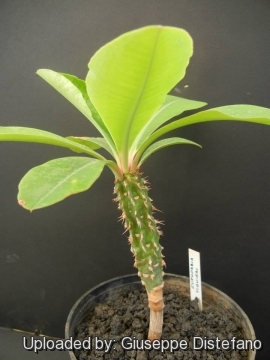 Euphorbia viguieri Photo by: Giuseppe Distefano
Euphorbia viguieri Photo by: Giuseppe Distefano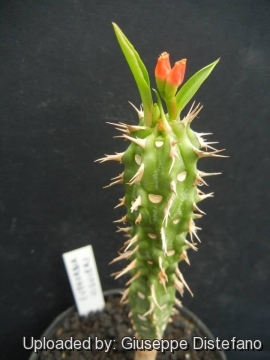 Euphorbia viguieri Photo by: Giuseppe Distefano
Euphorbia viguieri Photo by: Giuseppe Distefano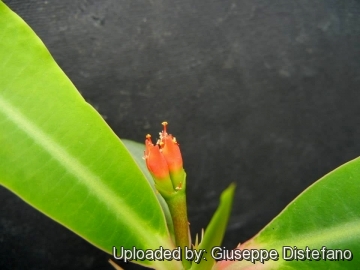 Euphorbia viguieri Photo by: Giuseppe Distefano
Euphorbia viguieri Photo by: Giuseppe Distefano Flowering habit at Iao Tropical Gardens of Maui, Maui, Hawaii (USA). May 22, 2012 Photo by: Forest Starr & Kim Starr
Flowering habit at Iao Tropical Gardens of Maui, Maui, Hawaii (USA). May 22, 2012 Photo by: Forest Starr & Kim Starr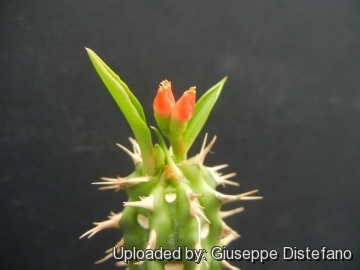 Euphorbia viguieri Photo by: Giuseppe Distefano
Euphorbia viguieri Photo by: Giuseppe Distefano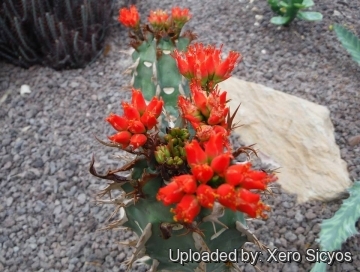 Euphorbia viguieri Photo by: Xero Sicyos
Euphorbia viguieri Photo by: Xero SicyosCultivation and Propagation: Euphorbia viguieriSN|25966]]SN|25966]] is a very ornamental species, easy to grow and suited for any well drained soil on bright light. It can be cultivated in open air in tropical or subtropical climate zones, in full sun, or (preferably) in light shade, on perfectly draining calcareous soils. But young plant are happy growing indoors too.
Growing rate: It is a slow grower.
Exposure: These plants don't seem to love being blasted by the sun in the summer but prefer bright light, and will therefore not make demands on your prime growing space. However shade grown plants will tend to produce fewer, and etiolated growth (weak, gangly stems with unusually long internodes, and generally paler green coloration). The colour of this plant is much more marked if grown in full sun.
Watering: It is relatively flexible in its watering requirements. It needs much water when it is growing. It can be watered regularly as long as the medium is open and well drained. As with any normal plant when watering, it is best to do so thoroughly, until a little water comes out through the drain holes. Allow the medium to dry out somewhat between waterings. Reduce watering during winter. Space plants apart to allow air movement between branches and leaves. This will help with evaporation of extra water droplets collected during watering. It is prone to rot in winters if watered much.
Soil: The ideal potting-medium is one with good moisture-retaining capacity but open and well drained with a little lime gravel.
Fertilization: Use fertilizer with low nitrogen and high phosphorus and potassium ratios. Feed during spring and withhold feeding during winter.
Hardiness: Very tender, protect from frost . Temperature spring to autumn: nocturnal at least 18°C and diurnal up to 38°C. Wintering: nocturnal 12°C and diurnal 20°C or more.
Warning: All the parts of the plant are considered as toxic. As with all other Euphorbias when a plant get damaged it exudes a thick white milky sap known as latex. This latex is poisonous and particularly dangerous for the eyes, skin and mucous membranes. So pay extreme attention not to get any in your eyes or mouth. Cultivated plants must be handled carefully.
Propagation: By seeds.
















